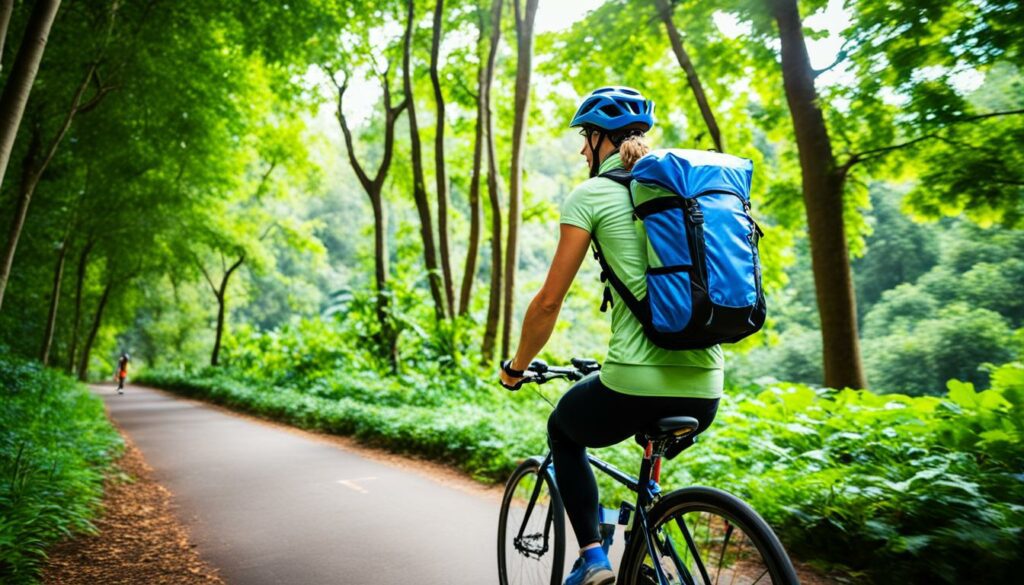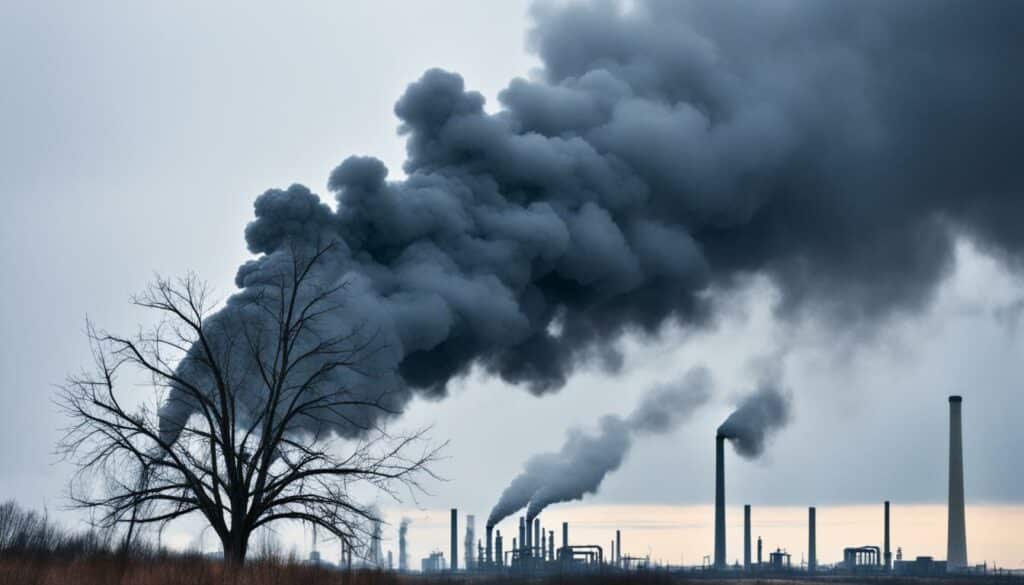Menu

Did you know over 1.1 million U.S. students faced school closures due to extreme weather? This fact shows how crucial it is to deal with our environmental impact. It also stresses the value of knowing our carbon footprint. In Dublin, at Big Pond Education, I learnt a lot. Big Pond is all about protecting the climate.
My internship taught me about being green when studying abroad. We looked at how to achieve zero net carbon emissions. This meant checking how much energy we used and living more sustainably. Time at Big Pond Education opened my eyes. It made me even more dedicated to doing my bit for our planet’s future.
I chose to study abroad to experience different cultures and expand my horizons. Ireland was my pick, known for its history and beautiful lands. Yet, I worried about the environmental cost.
I found Big Pond Education, a group that shares my love for the planet. They focus on green practices. This aligned with my wish to live sustainably.
Going to Ireland for studies had a big goal for me. I wanted new adventures and to grow academically and personally. Importantly, I wanted my actions abroad to lessen my impact on the planet.
This choice was rooted in the worldwide worry about our climate. It urged me to learn how my lifestyle affects the environment. So, understanding my carbon footprint was key.
In Ireland, I became keenly aware of my environmental impact. Every choice I made affected our planet, from what I ate to how I travelled. Thankfully, Big Pond Education helped a lot.
They taught me to measure and cut my carbon footprint. Their My Carbon Footprint programme was enlightening. It covered how my choices and our environment are linked.
The course was in three parts: Cycles, My Carbon Footprint, and Taking Action. The Cycles section broke down tricky terms like Carbon Sink and Carbon Dioxide Emission. It used fun tools like Jenga to explain the balance of emissions and sinks.
Learning from this, I realised even small changes can help the planet. This inspired me to look for ways to live greener. It also showed the value of schools teaching about sustainability, similar to what Big Pond Education was doing.
During my study abroad semester in Dublin, Ireland, I interned at Big Pond Education. This firm is famous for its work on climate protection and sustainability. It reflects my deep beliefs.

I was drawn to Big Pond Education because it shares my love for the environment. Research shows most of my generation looks for jobs in line with their values. Big Pond’s focused on sustainability in business and its innovative projects caught my eye.
At Big Pond, I handled detailed carbon accounting work. I looked at reducing the company’s carbon impact. The work made me see how my flight created a large CO2 amount.
Big Pond offsets student return flights’ carbon through planting trees. This shows climate protection in action. It’s practical and inspiring.
At Highfield House, I saw the importance of eco-friendly buildings. I helped with teaching the Carbon Literacy Initiative. This program equips students with skills for sustainable business.
The internship was more than work. It was a journey towards promoting sustainability. It taught me how to match my career with my values and help in climate action.
It’s vital to know how big our carbon footprint is for smart environmental choices. My 11,000 km flight to Ireland showed me this, especially compared to daily activities. Using carbon calculators, I could see the environmental impact clearly.
Seeing how much my flight impacted the environment was a big change for me. I used tools like Atmosfair to work out the specific CO2 from my flight. This showed me that long flights really add to our carbon footprint. It highlighted the big environmental hit of international trips.
The info from these calculators was really eye-opening. They gave a detailed look at our CO2 output, making me understand flying’s environmental cost. This new knowledge shaped my choices in Ireland and reminded me to think about the earth before future flights.
“Calculating one’s travel emissions offers essential insights, fostering a greater awareness of individual carbon footprints and promoting more sustainable choices.”
I focused a lot on reducing my carbon footprint at Big Pond Education. We looked into ways like carbon offsetting, onsetting, and insetting. We also supported local sustainability initiatives. This showed Big Pond’s aim to meet net zero targets.
Offsetting means making up for the carbon we use by saving the same amount somewhere else. This could be by funding reforestation or renewable energy projects. Onsetting aims at cutting emissions where they’re made. For us, this meant choosing organic, seasonal, and local food. It also meant eating in local restaurants instead of chains. This was preferred by 37% of students. Insetting is about reducing emissions within our activities, ensuring they are sustainable all around.

Getting involved in local sustainability initiatives was key during my study abroad. It was essential in aiming to achieve our net zero goals. We saw a big 63% jump in students who volunteered for environmental projects. These projects included reforestation work with partners like HomeTree. Also, 51% of us chose tourist spots that could be reached by train or bus instead of flying. This cut down our carbon use a lot. Another smart move was using water filters instead of buying plastic bottles. It was an example of how simple, thoughtful changes can go a long way.
Here’s a table showing the eco-friendly choices students made during their study abroad:
| Sustainable Practice | Participation Increase |
|---|---|
| Public Transport/Walking/Biking | 74% |
| Eco-Friendly Packing | 58% |
| Volunteering Projects | 63% |
| Organic, Seasonal, and Local Food | 46% |
| Vegetarian Diet | 72% |
| Reusable Bottles | 69% |
| Purchase from Local Artisans | 84% |
| Engage Friends in Sustainability Discussions | 57% |
These steps show how study abroad can play a big part in sustainability initiatives. They highlight how working together can help us reach our net zero goals.
My work with Big Pond Education showed me the power of aiming for net zero carbon. They worked hard to balance out the carbon footprint of their study abroad programmes. Looking at the full picture is key to cutting carbon.
It’s a bit like Apple’s big target for zero emissions by 2030. They plan to lower their emissions by 75% and to take away the last 25%. This shows how important it is for businesses to save energy and use renewables.
Big Pond and Apple both have cool ways to reduce their impacts. Apple cut 4.3 million tons in 2019 by using less and recycling more. Now, over 70 Apple suppliers make their stuff with 100% green energy, helping to avoid 14.3 million tons of CO2 each year.
Table: Emission Reduction Comparisons
| Company | Emission Reduction (Metric Tons) | Key Initiatives |
|---|---|---|
| Apple | 4.3 Million | Design and recycled content innovations |
| Apple’s Suppliers | 779,000 (Annualised) | Supplier Energy Efficiency Program |
| Apple (Renewable Energy) | 14.3 Million (Annualised) | Commitment to 100% renewable energy |
Seeing these efforts, I know how tough it is to make study abroad truly eco-friendly. Everything counts, from big flights to daily tasks. Big Pond paved the way, showing how to be green from the ground up in education.
At Big Pond Education, I met many challenges on the road to becoming carbon neutral. Our biggest hurdle was understanding carbon accounting. We had to accurately record emissions from different sources. This meant we had to learn a lot about how carbon is calculated.
Working through the complexities of carbon accounting showed us the big picture. We had to figure out the emissions from activities like living, travelling, and studying. It’s a detailed process called the Life Cycle Assessment (LCA). This was so tough because we had to look at everything to understand the full impact of what we were doing.

Another major issue was the rise of greenhouse gases in our atmosphere. They’ve gone from 280 ppm before the industrial era to 410 ppm in 2019. This is way above the safe limit of 350 ppm for carbon dioxide. It shows just how crucial it is to keep track of our carbon emissions very accurately.
Transatlantic flights were a key part of our carbon problem. They are very important but also a big challenge for carbon neutrality. Researchers say that air travel and other transport cause most of the emissions at events and study programmes. This means short conferences can have the carbon impact of many households for a week, mainly because of flights.
To tackle this, we found some clever solutions. Hosting workshops online instead of in-person reduces the carbon footprint by up to 88%. Also, if we do a mix of online and in-person (hybrid), 46% online, we cut down emissions by 82%. This proves that dealing with the carbon from flights is essential for real sustainable practices.
My work showed me that to be carbon neutral, everything must be looked at closely. Especially, we have to manage the huge effects of transatlantic flights.
It’s crucial to see how what we do affects the planet. Programs abroad, like those from Big Pond Education, help a lot. They teach students about the environment and how to fight climate change.
Learning about the environment changes how we think and act. Adding this topic to school lessons makes students aware. Did you know, each person makes around four tons of carbon dioxide yearly? In the US, that number jumps to 16 tons. This big difference shows why we need lessons on climate change. They are important to help everyone understand and make a difference.
Teaching others can lead to big changes against climate change. Tools like the CoolClimate Calculator and the EPA Household Calculator help. They show us where we are making the most impact. This way, we can adjust our habits. For example, using a car by yourself makes more carbon dioxide than sharing it with others or using the bus. Understanding this, we can choose better. We can pick the best ways to travel every day or use energy at home. This leads to living more sustainably.
| Resource | Application | Impact |
|---|---|---|
| CoolClimate Calculator | Measures home, travel, food, and shopping emissions | Encourages comparison and reduction strategies |
| Zerofootprint Youth Carbon Calculator | Calculates family carbon footprint | Promotes family-wide sustainable practices |
| EPA Household Carbon Footprint Calculator | Considers home energy, cars, and recycling emissions | Assists in decreasing overall household impact |
Adding environmental studies in abroad programmes prepares young people for the future. It inspires them to find new ways to reduce carbon. And pushes them to use more renewable energy and farming methods. By learning about climate change, we can work towards a world that lasts longer.
Energy-efficient housing is vital for reducing our global impact. The building of homes uses a lot of energy. In fact, it makes up around 10% of the world’s total energy use. Building sustainably can really help. For example, in the U.S., how we use our homes is as bad for the planet as a whole country’s emissions.

Big Pond Education shows how we can cut carbon footprints with smart housing choices. They pick Nearly Zero Emissions Buildings for students studying away from home. These buildings are much better for the environment. Research says that crowded areas pollute less than those spread out. So, their choice of housing types is a big win for the Earth.
Using renewable energy is a major step in the right direction. For student housing, going electric can cut a lot of emissions. The use of solar power by Big Pond Education is a great example of their green commitment. Also, building homes elsewhere and bringing them in saves energy and is more efficient in the long run.
This effort doesn’t just help the planet. It supports those who are hit hardest by climate change, like the poor. By designing homes smartly, less heat gets wasted. This keeps energy use down and also lowers emissions when the homes are built.
| Housing Type | Energy Use Reduction | GHG Emissions Reduction |
|---|---|---|
| Multi-family housing | 35% | 40% |
| Offsite construction | 20% | 25% |
| Passive House design | 50% | 60% |
In summary, using energy-efficient housing and renewable energy is key for a cleaner planet. Big Pond Education is making a real impact with its green choices. Such steps are crucial in our battle against climate change.
During my study abroad, I learned about how students affect our planet. This includes how they get to school, take field trips, and travel for fun. Each action, no matter how small, has an impact on the environment every day.
Students’ activities play a big role in their environmental impact. For example, school buses in the U.S. alone number nearly 480,000. Also, K–12 schools create 53,000 tons of food waste each year.
These facts made me see that our daily choices matter. They can add up to make a big difference to our planet’s health.
Big Pond Education helped students make green choices. They encouraged the use of renewable energy in schools. They also proposed switching to electric buses, which saves a lot of money over time.
The Batesville School District saved lots of money by putting up solar panels. This paid for half of their energy use. Such steps help the environment and teach students to be responsible.
To help our planet, it’s important to be eco-friendly in daily life. Whether it’s cutting down on travel or supporting local green projects, every step matters. Working with Big Pond Education showed me we all can make a difference.
My job at Big Pond Education showed me how key insetting strategies are for true sustainability in study abroad. Unlike carbon offsetting, insetting focuses on reducing emissions internally within an organisation. This means a direct cut in greenhouse gases from activities part of study abroad.
One big part of insetting is improving how we use energy. A significant amount of emissions come from travelling to and from study spots. Finding ways to lower these emissions is crucial. We do this by using green homes, eco-friendly local travel, and renewable power.

During my time at Big Pond Education, we used many insetting methods. We pushed for students to fly economy class to cut down on air pollution. We also got students to think about their travel choices. Plus, we closely watched and managed the carbon footprint made by students, where they stayed, and how they got around every day.
These team efforts show our deep commitment to a sustainable study abroad scheme. Insetting is all about taking real steps to combat climate change. It shows how much we care about our students learning to be environmentally responsible. This approach helps shape their values on sustainability during their study trips.
I worked with Big Pond Education. We teamed up with HomeTree, a local charity in Ireland. This charity focuses on planting more trees. By working together, we did more than lower our carbon output. We also helped improve Ireland’s natural environment.
Our partnership with HomeTree was key. It allowed us to plant trees in Ireland. This action helped reduce our environmental impact and increased local plant and animal life. Our work was a vital part of making Ireland greener.
We got students involved in planting trees. This gave them real-world lessons in taking care of the Earth. They planted 914 trees in Larne during 2012-2013. It taught them how important trees are for the climate and the planet’s health.
Students learned to appreciate and protect Ireland’s nature. Reforestation balanced out the impact of their overseas studies. It also deepened their love for the planet.
Here are the numbers that show how much our work mattered:
| Environmental Metric | Before Tree Planting | After Tree Planting |
|---|---|---|
| Water Consumption (Larne, 2012-2013) | 36% Increase | – |
| Waste Diversion Rate (2012) | 48% | 59% |
| Carbon Footprint (tonnes, Larne) | 1771 | 1669 |
| Energy Use per Employee (tonnes) | 5.82 | 5.64 |
| Fuel Consumption (carbon equivalent tonnes) | 624 | 562 |
| Recycling Rate (2011) | 51% | – |
| Tree Planting (Larne, 2012-2013) | 0 | 914 Trees |
| Reduction in Fuel Consumption (4 years) | 0% | 14% |
| Energy Use Reduction (4 years) | 0% | 30% |
Our work in planting trees and other green projects is making Ireland better. We are reducing our environmental harm and creating a brighter future for everyone.
Big Pond Education is all about teaching climate education curricula to help students face environmental issues. They blend climate learning into their lessons, making sure tomorrow’s leaders understand how to create a sustainable future.

The climate change class at San José State University (SJSU) shows a great way to teach. It lasted a year and students came from different fields, like Social Sciences and Business. It was taught by top professors from different areas, focusing on climate science and ways to help the environment.
This approach aimed to change students’ actions, getting them to help tackle climate issues in their lives and work.
A study looked at 104 students who took the SJSU course. It found they cut down 2.86 tons of CO2 yearly through their actions. This result shows how teaching about climate change can lead to real, positive changes for the planet.
The success of the SJSU course shows why more schools worldwide should promote climate literacy certification. Even though not all countries focus on this yet, there is a strong push in the U.S. for climate change education. Over 86% there believe it is very important. This shows a global trend towards preparing younger generations for a sustainable future.
Working with Big Pond Education changed how I see the environment and personal growth. It wasn’t just for school; it was real-life lessons in choosing career paths that help the planet.
My time at Big Pond Education made me really think about the planet. I joined a team that cared a lot about the environment. They taught me how important reducing our carbon footprint is for big environmental goals. This made me see how everyone’s small actions can add up to something huge.
It made me want to work in places that are all about caring for the Earth. I really want to be part of something that makes a difference. Seeing how much good smart environmental choices can do has made me even more focused on this career path.
Now, I feel ready to work towards a green future. I’m excited to put what I learned to use, making sure every job I do helps our planet. This experience at Big Pond Education has truly inspired me.
| Aspect | Statistics |
|---|---|
| MEM students securing internships globally | Percentage of students at the Nicholas School of the Environment |
| Climate Scenario Analysis | Internship focus for Jenny Jiwon Hyun |
| Career & Professional Development Center (CPDC) | Number of students receiving guidance |
| Nicholas School’s MEM alumni network | Impact rate on internship placements |
| International student support | Number of Nicholas School students acclimated to US professional environments |
During my time learning about carbon footprint, I saw how knowing and doing can really change things. Working at Big Pond Education taught me a lot, both in class and within myself. I realised that learning can make us act in better ways.
In today’s world, how we affect the environment is under a lot of scrutiny. Courses like COMM 168 are key. They show we can cut down on our personal CO2 emissions by 2.86 tons a year. Partnerships like the Talloires Declaration and groups like AASHE point out how universities are key in this learning.
Big Pond Education goes further. They make sure learning for the planet is at the heart of what they do. This pushes everyone towards thinking and acting greener. My time there showed me how important this knowledge is. It helped me change how I see and do things for the planet.
Learning about carbon footprints shows us how our actions affect the planet. It teaches us to live in ways that are kind to Earth. By learning, we can help protect the climate and look after our world for the future.
Studying in Ireland was a way for me to experience a new culture and support the environment. I was driven to learn more about reducing carbon footprints. This chance helped me link my studies with helping the planet.
Big Pond Education helped me a lot in understanding carbon footprints. They focused on cutting down emissions and promoting Earth-friendly plans. Their work matched my passion for saving our planet.
I used a tool from Atmosfair to understand my flight’s impacts. It showed me how my journey affected the environment. This was a key lesson in studying abroad and being aware of our carbon footprints.
Offsetting is about investing in efforts to balance environmental harm. Onsetting is working to lessen emissions in the local community. Insetting involves making the company’s own operations less harmful. Big Pond Education combined these methods to reduce their carbon impact.
As part of my internship, we did activities like planting trees with HomeTree. We also improved how energy was used in student homes and encouraged renewable energy. These steps helped us lessen our impact and do good in the community.
Measuring carbon footprints accurately was tough. I had to account for everything, from long flights to daily life. It was hard work to ensure my calculations were right for working towards a carbon-neutral goal.
Environmental learning, like at Big Pond Education, teaches us to battle climate issues head on. It helps us value sustainable living and take real steps to reduce our carbon footprint. This is key to making a difference in the wider world.
Choosing greener homes and using renewable energy is key. It cuts down the emissions of study abroad programmes. This lessens their impact on the planet and teaches students to live sustainably.
By making smart choices daily, like using buses and recycling, students can cut their carbon footprint. Even small efforts add up to big changes for the environment.
Insetting means working on our own operations to lower emissions. It shows true commitment to the environment. By acting within, we make a real difference for the planet long term.
Working with HomeTree to plant trees locally was a great step for the environment. It allowed students to join efforts in reforestation, getting in touch with nature. This supported ecological health all around.
Programmes like those at Big Pond Education prepare students to face climate issues. They arm us with the knowledge to make real, green changes. These lessons turn us into future leaders for the environment.
My time at Big Pond showed me the importance of environmental care. It motivated me to continue working for a green future. Now, I’m focused on making a positive impact on the planet.